Optimising Electrical Power Supply Sustainability Using a Grid-Connected Hybrid Renewable Energy System—An NHS Hospital Case Study
Abstract
:1. Introduction
2. Methods
2.1. Data
2.1.1. Electricity Consumption Data
2.1.2. Carbon Intensity
2.1.3. Solar Irradiance Data
2.2. System Architecture
2.3. Electrical Power Modelling
2.3.1. PV Array
2.3.2. Battery Bank
2.3.3. Grid Electricity
2.4. Dispatch Strategy
2.5. Cost Modelling
2.5.1. Cost Parameters of System Components
2.5.2. Forecasted Cost Parameters
2.6. Multi-Objective Optimisation
Optimisation Methodology
3. Results and Discussion
3.1. Grid Carbon Intensity Forecasting
3.2. Optimum PV-Battery System
3.3. Optimisation Using Forecasting Data
4. Discussion of the Results
5. Conclusions
- -
- In the UK healthcare context, installing grid-connected HRES can be economically viable and can even help reduce the cost of energy than grid-only system, yielding cumulative savings in the same order of magnitude as the initial cost over the lifetime of the system. A side benefit includes dampening the effects of grid-price fluctuations on the overall energy cost of the hospital. Given the long term trend of electricity price increase in the UK, the system can become more profitable with time.
- -
- Installing grid-connected HRES will directly address the NHS ambition of becoming net-zero health provider. A Net-zero system for the hospital section under study, will save around 2000 tonnes of over 25 years of project life.
- -
- If our projections of grid-emissions and cost parameters are accurate, then the optimum systems will become more cost effective in the future.
- -
- Incorporating forecasting into the optimisation helped in selection of the most suitable subsets of the Pareto solutions, which was not obvious without using this approach.
- -
- A significant drop in storage prices or a change in the exports to the grid mechanisms are needed to make the grid-PV-battery system the optimal choice. Significant reductions in battery prices are expected over the coming years and changes to export incentives by offering higher rates for customers with storage are starting to emerge in the UK electricity market.
Author Contributions
Funding
Institutional Review Board Statement
Informed Consent Statement
Data Availability Statement
Conflicts of Interest
Abbreviations
| NHS | National Health Service (UK) |
| WEDL | Wireless Electricity Data Logger |
| HH | Half Hourly rate |
| O&M | Operation and Maintenance |
| HRES | Hybrid Renewable Energy System |
| GC | Grid-connected |
| GBP | Pound Sterling |
| GBp | Penny Sterling |
| PV | Photovoltaic |
| GHI | Global horizontal irradiance |
| UB | Upper bound (optimisation) |
| LB | Lower bound (optimisation) |
| STC | Standard test conditions (PV modules) |
| CRF | Capital Recovery Factor |
| LCE | Levelised Cost of Energy |
| SoC | State of Charge (battery bank) |
| FiT | Feed-in-Tariff |
| MAPE | Mean Absolute Percentage Error |
References
- NHS. Delivering a ’Net Zero’ National Health Service; Technical Report; NHS England and NHS Improvement: London, UK, 2020.
- Shi, Y.; Yan, Z.; Li, C.; Li, C. Energy consumption and building layouts of public hospital buildings: A survey of 30 buildings in the cold region of China. Sustain. Cities Soc. 2021, 32, 103247. [Google Scholar] [CrossRef]
- NHS. NHS Energy Efficiency Fund—Final Report; Technical Report; National Health Service, Department of Health, UK Government: Cambridge, UK, 2015.
- Sinha, S.; Chandel, S. Review of software tools for hybrid renewable energy systems. Renew. Sustain. Energy Rev. 2014, 32, 192–205. [Google Scholar] [CrossRef]
- IRENA. Renewable Power Generation Costs in 2020; Technical Report; International Renewable Energy Agency: Abu Dhabi, UAE, 2021. [Google Scholar]
- Kahwash, F.; Maheri, A.; Mahkamov, K. Integration and optimisation of high-penetration Hybrid Renewable Energy Systems for fulfilling electrical and thermal demand for off-grid communities. Energy Convers. Manag. 2021, 236, 114035. [Google Scholar] [CrossRef]
- Satpathy, R.; Pamuru, V. Chapter 9—Grid-connected solar PV power systems. In Solar PV Power; Satpathy, R., Pamuru, V., Eds.; Academic Press: Cambridge, MA, USA, 2021; pp. 365–433. [Google Scholar] [CrossRef]
- Shen, Y.; Ji, L.; Xie, Y.; Huang, G.; Li, X.; Huang, L. Research landscape and hot topics of rooftop PV: A bibliometric and network analysis. Energy Build. 2021, 251, 111333. [Google Scholar] [CrossRef]
- Shabani, M.; Dahlquist, E.; Wallin, F.; Yan, J. Techno-economic impacts of battery performance models and control strategies on optimal design of a grid-connected PV system. Energy Convers. Manag. 2021, 245, 114617. [Google Scholar] [CrossRef]
- Hassan, M.; Saha, S.; Haque, M.E. A framework for the performance evaluation of household rooftop solar battery systems. Int. J. Electr. Power Energy Syst. 2021, 125, 106446. [Google Scholar] [CrossRef]
- Sevilla, F.R.S.; Parra, D.; Wyrsch, N.; Patel, M.K.; Kienzle, F.; Korba, P. Techno-economic analysis of battery storage and curtailment in a distribution grid with high PV penetration. J. Energy Storage 2018, 17, 73–83. [Google Scholar] [CrossRef]
- Zhang, S.; Tang, Y. Optimal schedule of grid-connected residential PV generation systems with battery storages under time-of-use and step tariffs. J. Energy Storage 2019, 23, 175–182. [Google Scholar] [CrossRef]
- Abushnaf, J.; Rassau, A.; Górnisiewicz, W. Impact of dynamic energy pricing schemes on a novel multi-user home energy management system. Electr. Power Syst. Res. 2015, 125, 124–132. [Google Scholar] [CrossRef]
- Gu, C.; Yan, X.; Yan, Z.; Li, F. Dynamic pricing for responsive demand to increase distribution network efficiency. Appl. Energy 2017, 205, 236–243. [Google Scholar] [CrossRef] [Green Version]
- Do Espirito Santo, D.B. An energy and exergy analysis of a high-efficiency engine trigeneration system for a hospital: A case study methodology based on annual energy demand profiles. Energy Build. 2014, 76, 185–198. [Google Scholar] [CrossRef]
- Lakjiri, S.; Ouassaid, M.; Cherkaoui, M. Enhancement of the energy efficiency in moroccan public hospitals through solar polygeneratlon system. In Proceedings of the 2016 International Conference on Electrical Sciences and Technologies in Maghreb (CISTEM), Marrakech & Bengrir, Morocco, 26–28 October 2016; pp. 1–6. [Google Scholar]
- Jahangir, M.H.; Eslamnezhad, S.; Mousavi, S.A.; Askari, M. Multi-year sensitivity evaluation to supply prime and deferrable loads for hospital application using hybrid renewable energy systems. J. Build. Eng. 2021, 40, 102733. [Google Scholar] [CrossRef]
- Perera, K.S.; Aung, Z.; Woon, W.L. Machine learning techniques for supporting renewable energy generation and integration: A survey. In Proceedings of the International Workshop on Data Analytics for Renewable Energy Integration, Nancy, France, 19 September 2014; pp. 81–96. [Google Scholar]
- Rolnick, D.; Donti, P.L.; Kaack, L.H.; Kochanski, K.; Lacoste, A.; Sankaran, K.; Ross, A.S.; Milojevic-Dupont, N.; Jaques, N.; Waldman-Brown, A.; et al. Tackling climate change with machine learning. arXiv 2019, arXiv:1906.05433. [Google Scholar]
- Taylor, S.J.; Letham, B. Forecasting at scale. Am. Stat. 2018, 72, 37–45. [Google Scholar] [CrossRef]
- Rangel-Martinez, D.; Nigam, K.; Ricardez-Sandoval, L.A. Machine learning on sustainable energy: A review and outlook on renewable energy systems, catalysis, smart grid and energy storage. Chem. Eng. Res. Des. 2021, 174, 414–441. [Google Scholar] [CrossRef]
- Khosravi, A.; Koury, R.; Machado, L.; Pabon, J. Prediction of hourly solar radiation in Abu Musa Island using machine learning algorithms. J. Clean. Prod. 2018, 176, 63–75. [Google Scholar] [CrossRef]
- Murugaperumal, K.; Srinivasn, S.; Prasad, G.S. Optimum design of hybrid renewable energy system through load forecasting and different operating strategies for rural electrification. Sustain. Energy Technol. Assess. 2020, 37, 100613. [Google Scholar] [CrossRef]
- Schleifer, A.H.; Murphy, C.A.; Cole, W.J.; Denholm, P.L. The evolving energy and capacity values of utility-scale PV-plus-battery hybrid system architectures. Adv. Appl. Energy 2021, 2, 100015. [Google Scholar] [CrossRef]
- Bhandari, B.; Lee, K.T.; Lee, G.Y.; Cho, Y.M.; Ahn, S.H. Optimization of hybrid renewable energy power systems: A review. Int. J. Precis. Eng. Manufact.-Green Technol. 2015, 2, 99–112. [Google Scholar] [CrossRef]
- Taha, A.; Wu, R.; Emeakaroha, A.; Krabicka, J. Reduction of Electricity Costs in Medway NHS by Inducing Pro-Environmental Behaviour Using Persuasive Technology. Future Cities Environ. 2018, 4, 1–10. [Google Scholar] [CrossRef] [Green Version]
- Operator, N.G.E.S. Carbon Intensity. 2021. Available online: https://www.carbonintensity.org.uk/ (accessed on 31 August 2021).
- Barakat, B.; Taha, A.; Samson, R.; Steponenaite, A.; Ansari, S.; Langdon, P.M.; Wassell, I.J.; Abbasi, Q.H.; Imran, M.A.; Keates, S. 6G Opportunities Arising from Internet of Things Use Cases: A Review Paper. Future Internet 2021, 13, 159. [Google Scholar] [CrossRef]
- Operator, N.G.E.S. Carbon Intensity Forecast Methodology. 2021. Available online: https://github.com/carbon-intensity/methodology (accessed on 31 August 2021).
- Harvey, A.C.; Peters, S. Estimation procedures for structural time series models. J. Forecast. 1990, 9, 89–108. [Google Scholar] [CrossRef]
- Photovolataic Geographical Information System (PVGIS); EU Science HUB. 2021. Available online: https://ec.europa.eu/jrc/en/pvgis (accessed on 31 August 2021).
- Bajpai, P.; Dash, V. Hybrid renewable energy systems for power generation in stand-alone applications: A review. Renew. Sustain. Energy Rev. 2012, 16, 2926–2939. [Google Scholar] [CrossRef]
- Wang, R.; Xiong, J.; He, M.f.; Gao, L.; Wang, L. Multi-objective optimal design of hybrid renewable energy system under multiple scenarios. Renew. Energy 2020, 151, 226–237. [Google Scholar] [CrossRef]
- HOMER Energy HOMER Pro V3.12 User Manual. Boulder, CO. Available online: https://www.homerenergy.com/products/pro/index.html/ (accessed on 31 August 2021).
- Baruah, A.; Basu, M.; Amuley, D. Modeling of an autonomous hybrid renewable energy system for electrification of a township: A case study for Sikkim, India. Renew. Sustain. Energy Rev. 2021, 135, 110158. [Google Scholar] [CrossRef]
- Mokhtara, C.; Negrou, B.; Bouferrouk, A.; Yao, Y.; Settou, N.; Ramadan, M. Integrated supply–demand energy management for optimal design of off-grid hybrid renewable energy systems for residential electrification in arid climates. Energy Convers. Manag. 2020, 221, 113192. [Google Scholar] [CrossRef]
- Cole, W.; Frazier, A.W.; Augustine, C. Cost Projections for Utility-Scale Battery Storage: 2021 Update; Technical Report; National Renewable Energy Lab. (NREL): Golden, CO, USA, 2021.
- Energy Prices Statistics Team, Department for Business, Energy & Industrial Strategy, E.I.S. Energy Prices Non-Domestic Prices; Technical Report; Government UK: London, UK, 2021.
- Ofgem. Smart Export Guarantee (SEG); Office of Gas and Electricity Markets: London, UK, 2021.
- Vartiainen, E.; Masson, G.; Breyer, C.; Moser, D.; Román Medina, E. Impact of weighted average cost of capital, capital expenditure, and other parameters on future utility-scale PV levelised cost of electricity. Prog. Photovolt. Res. Appl. 2020, 28, 439–453. [Google Scholar] [CrossRef] [Green Version]
- Mokhtara, C.; Negrou, B.; Settou, N.; Bouferrouk, A.; Yao, Y. Optimal design of grid-connected rooftop PV systems: An overview and a new approach with application to educational buildings in arid climates. Sustain. Energy Technol. Assess. 2021, 47, 101468. [Google Scholar]
- Bilir, L.; Yildirim, N. Modeling and performance analysis of a hybrid system for a residential application. Energy 2018, 163, 555–569. [Google Scholar] [CrossRef]
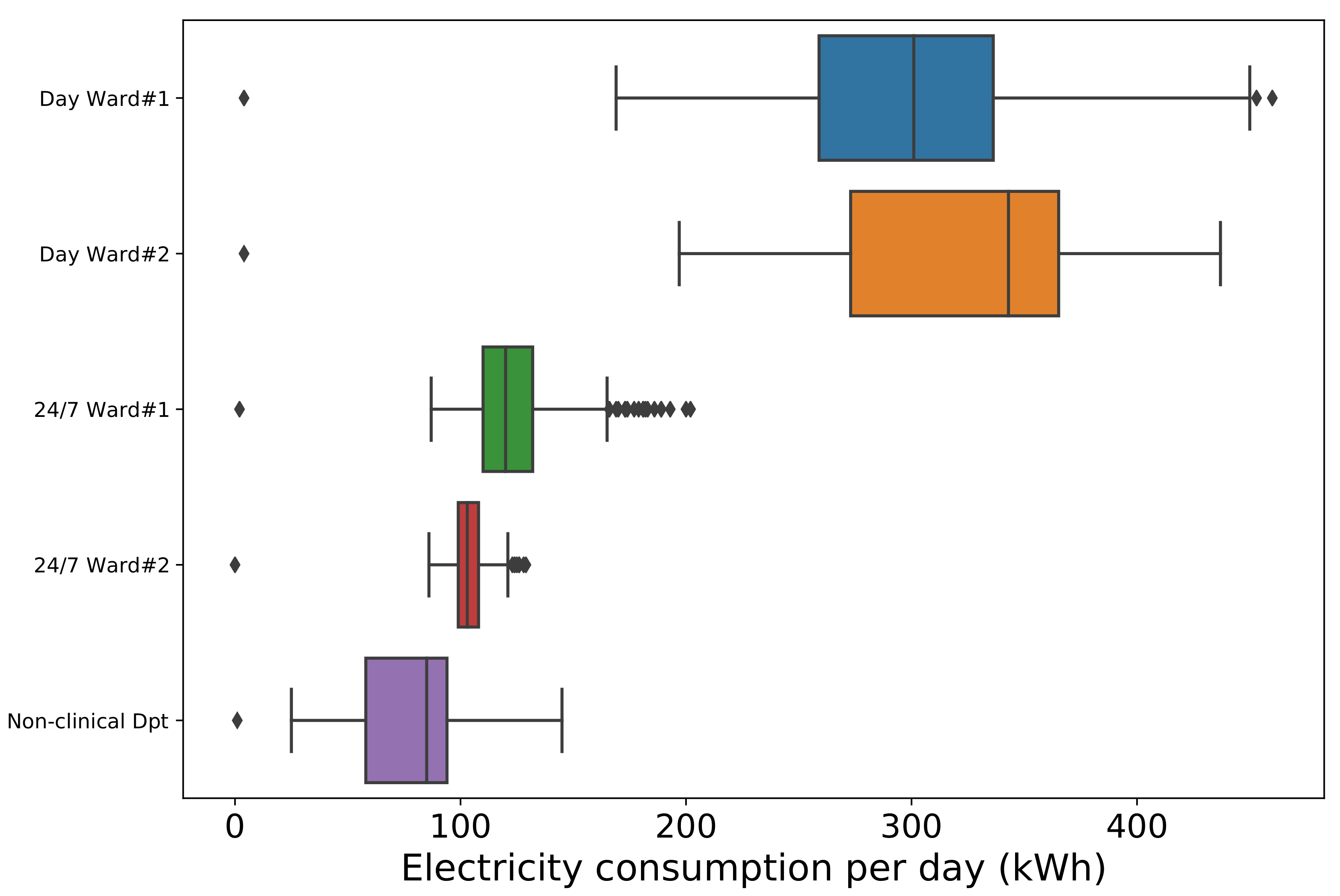
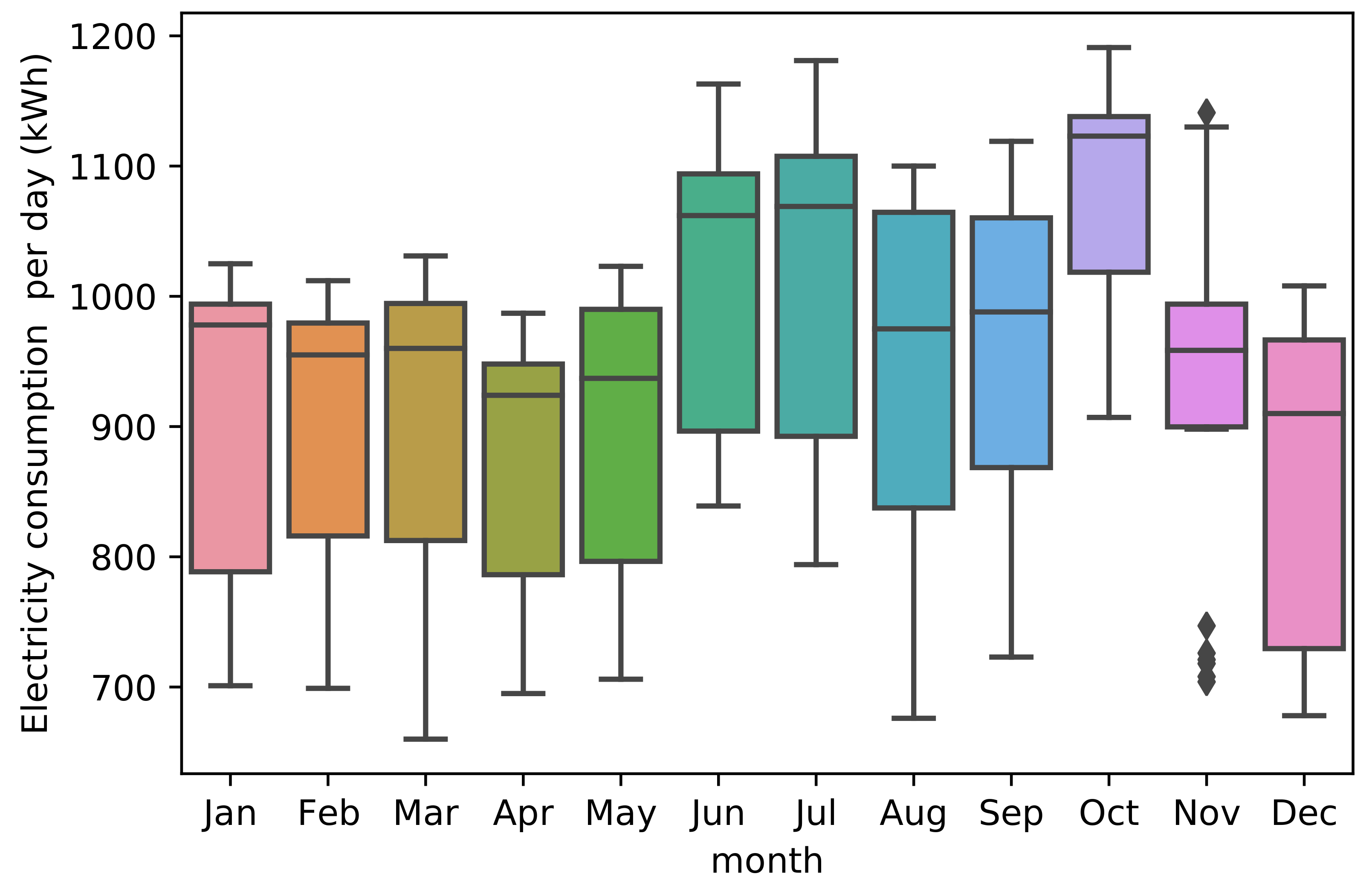
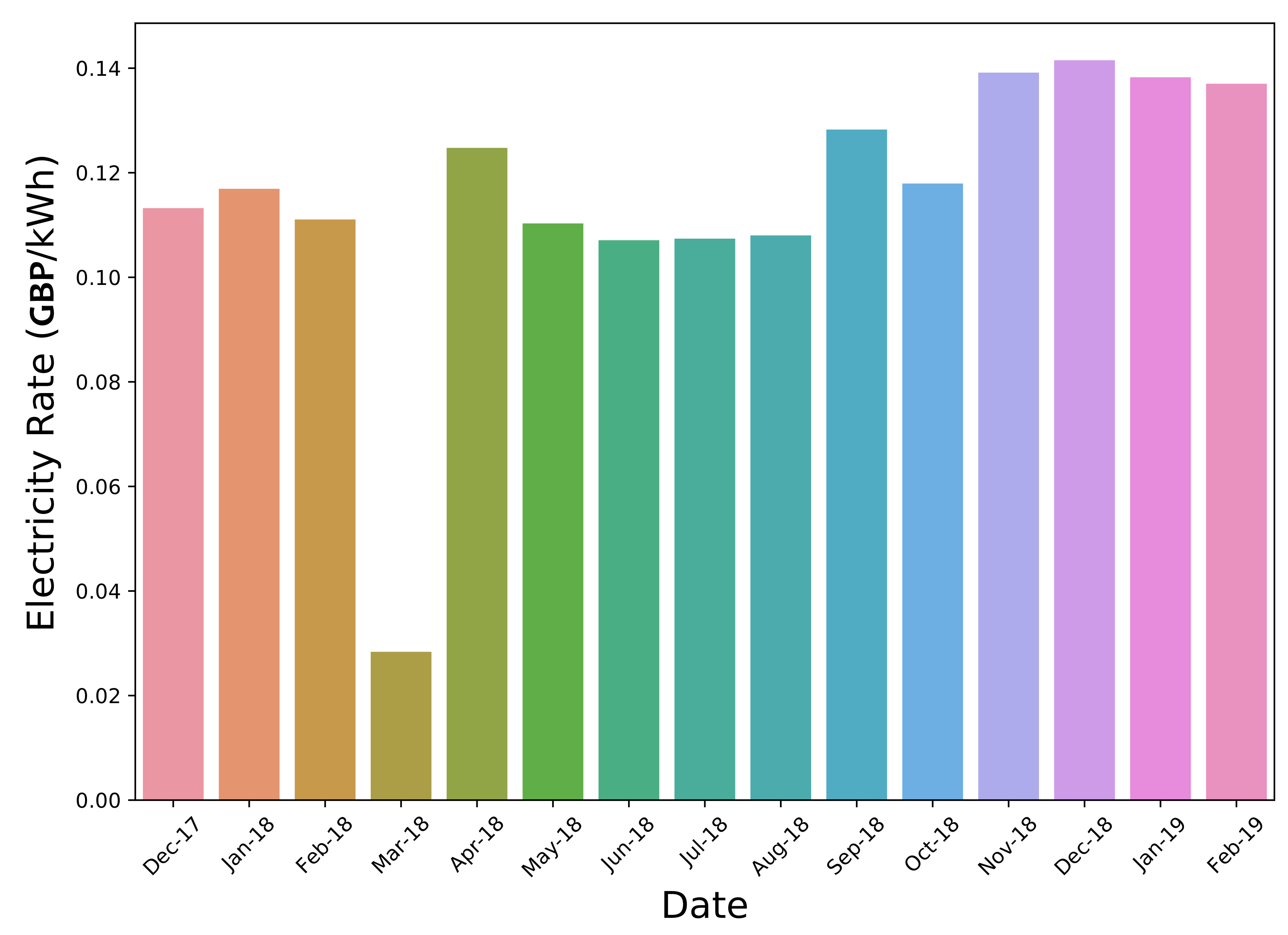
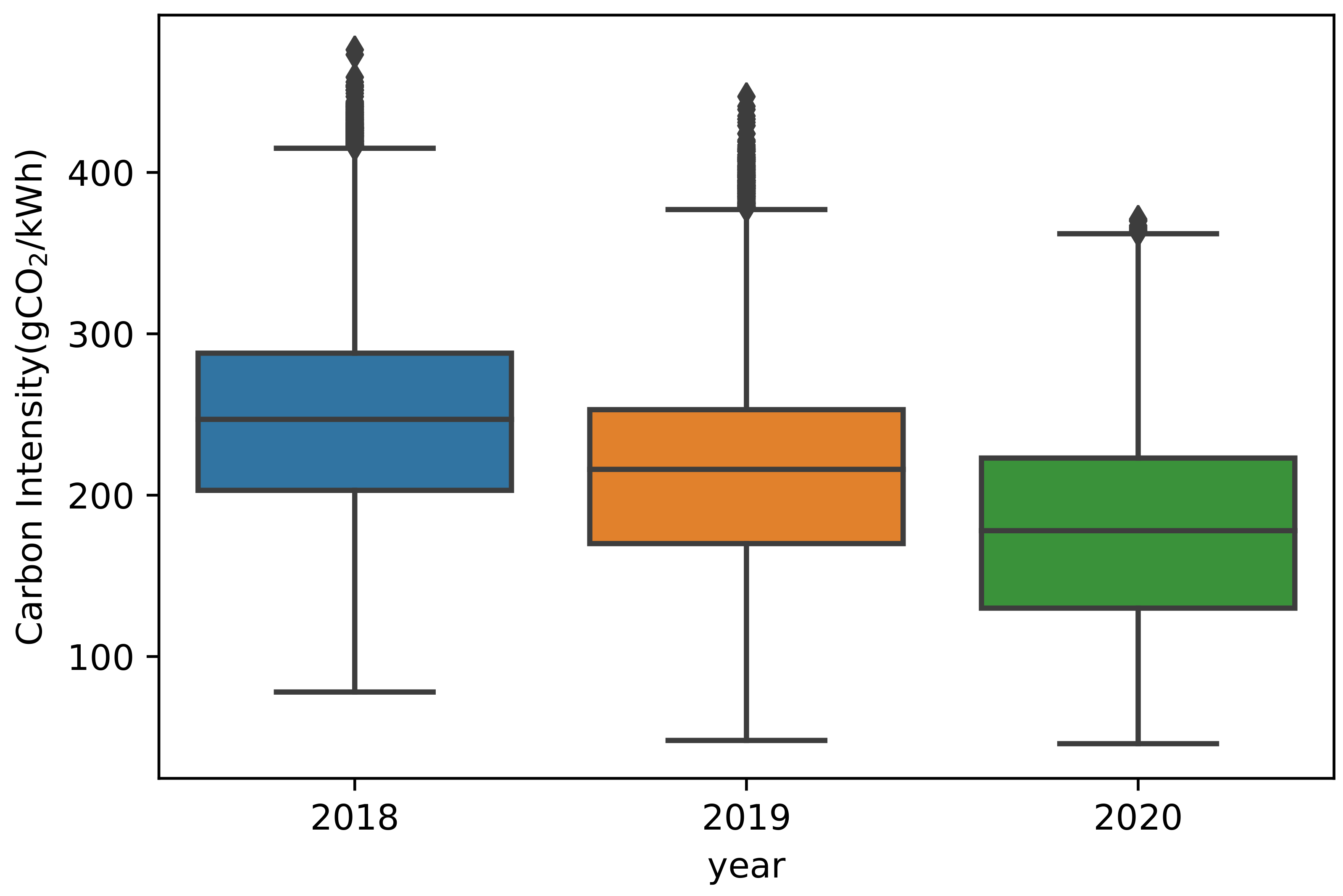
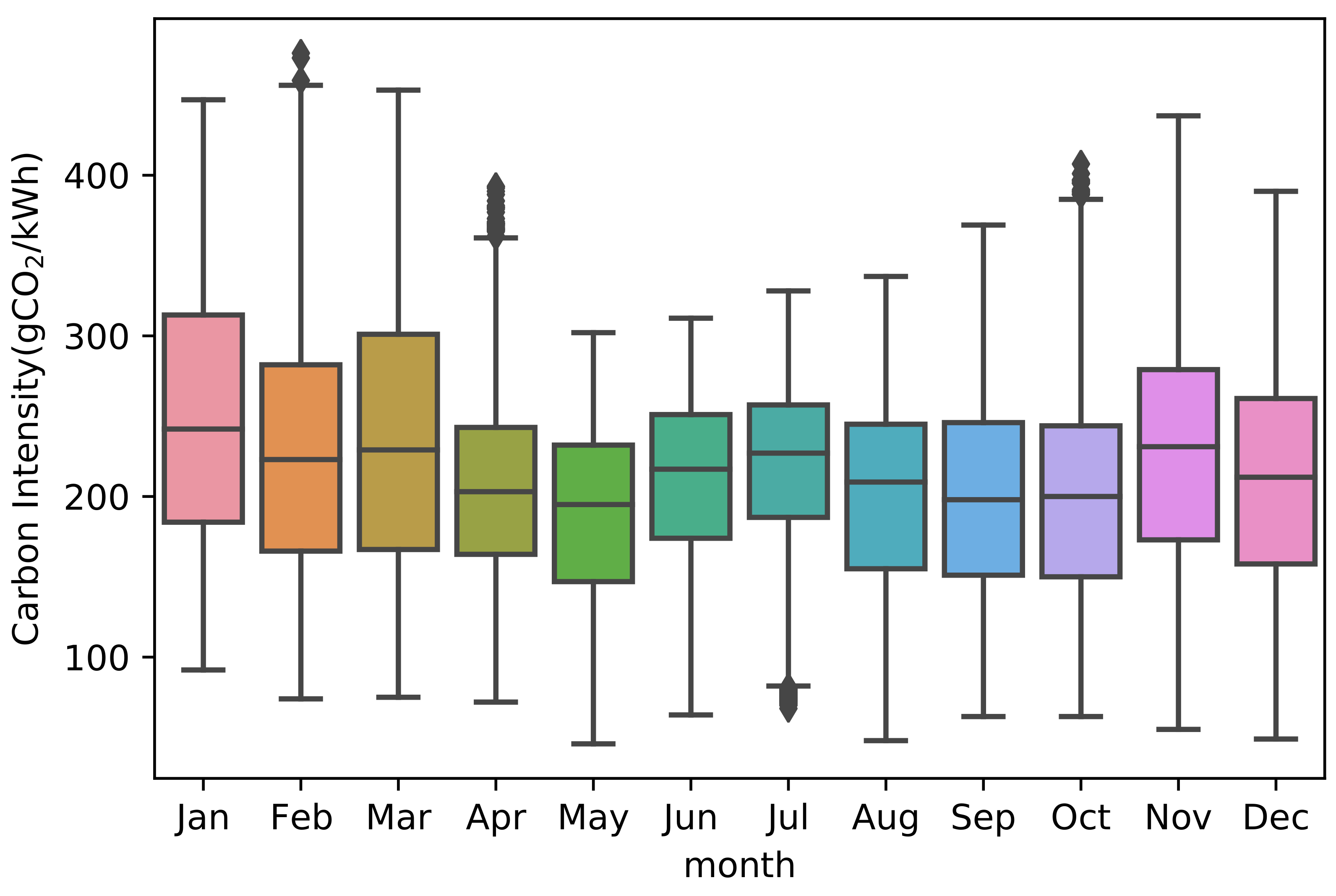
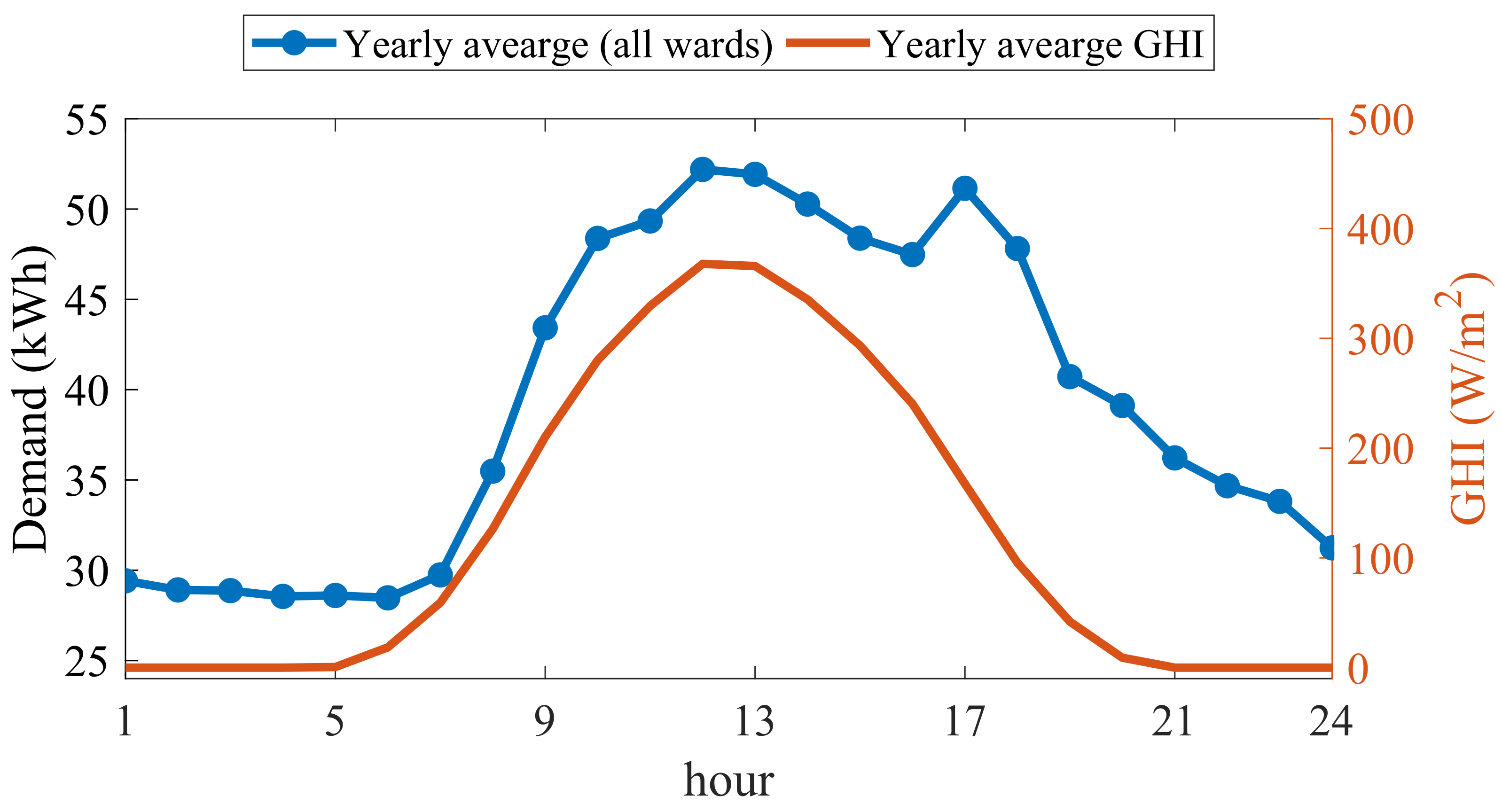
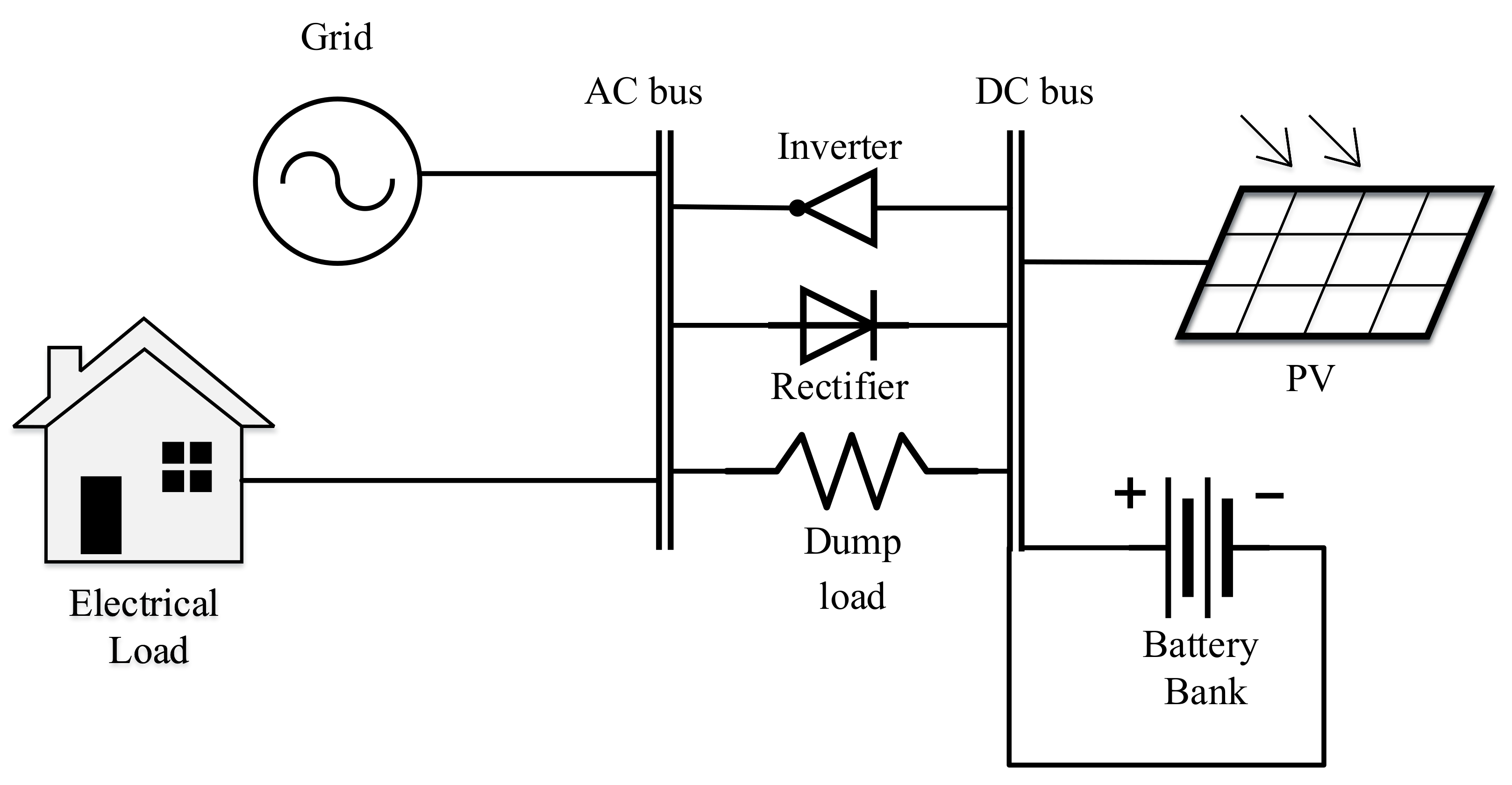
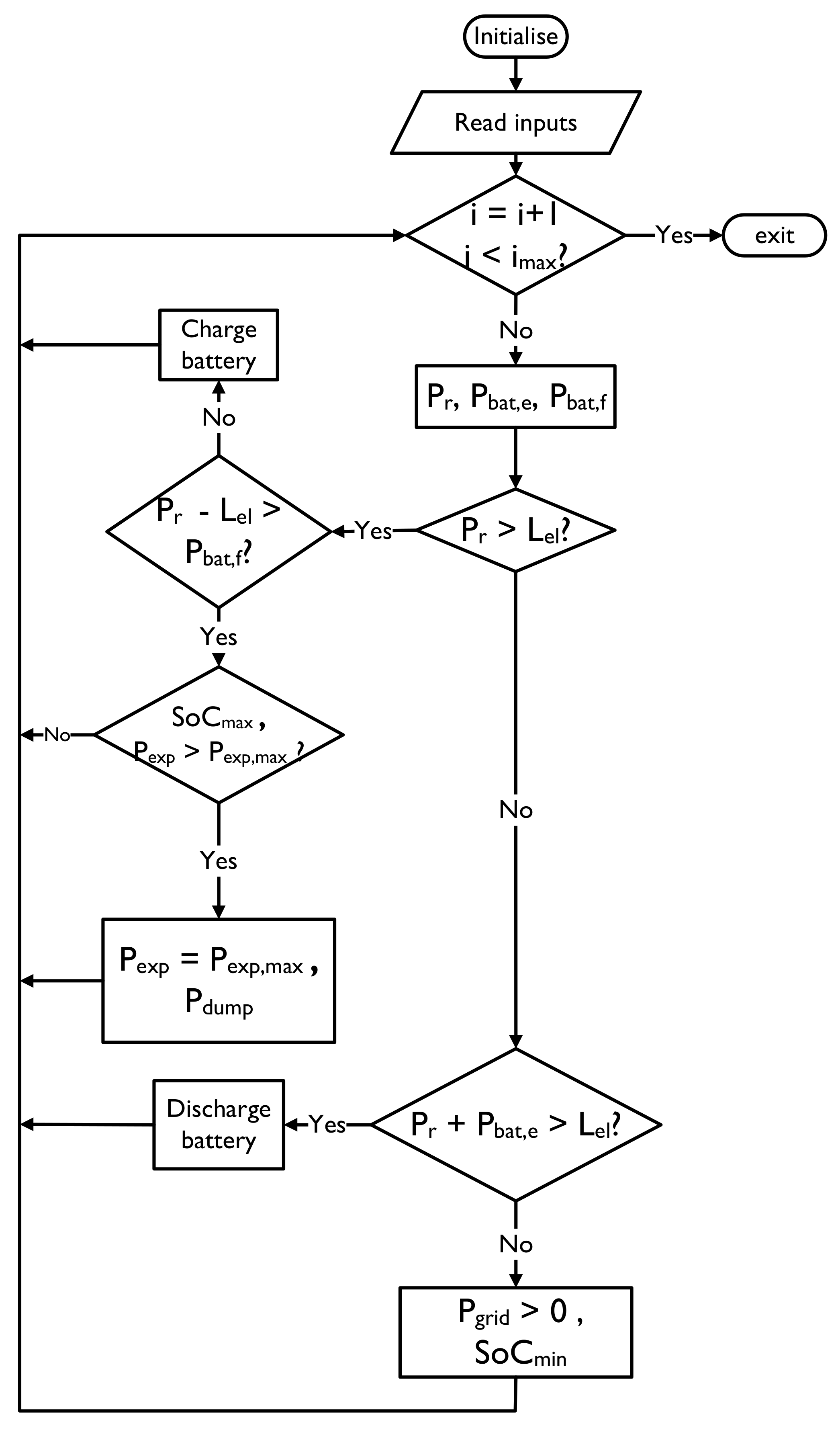
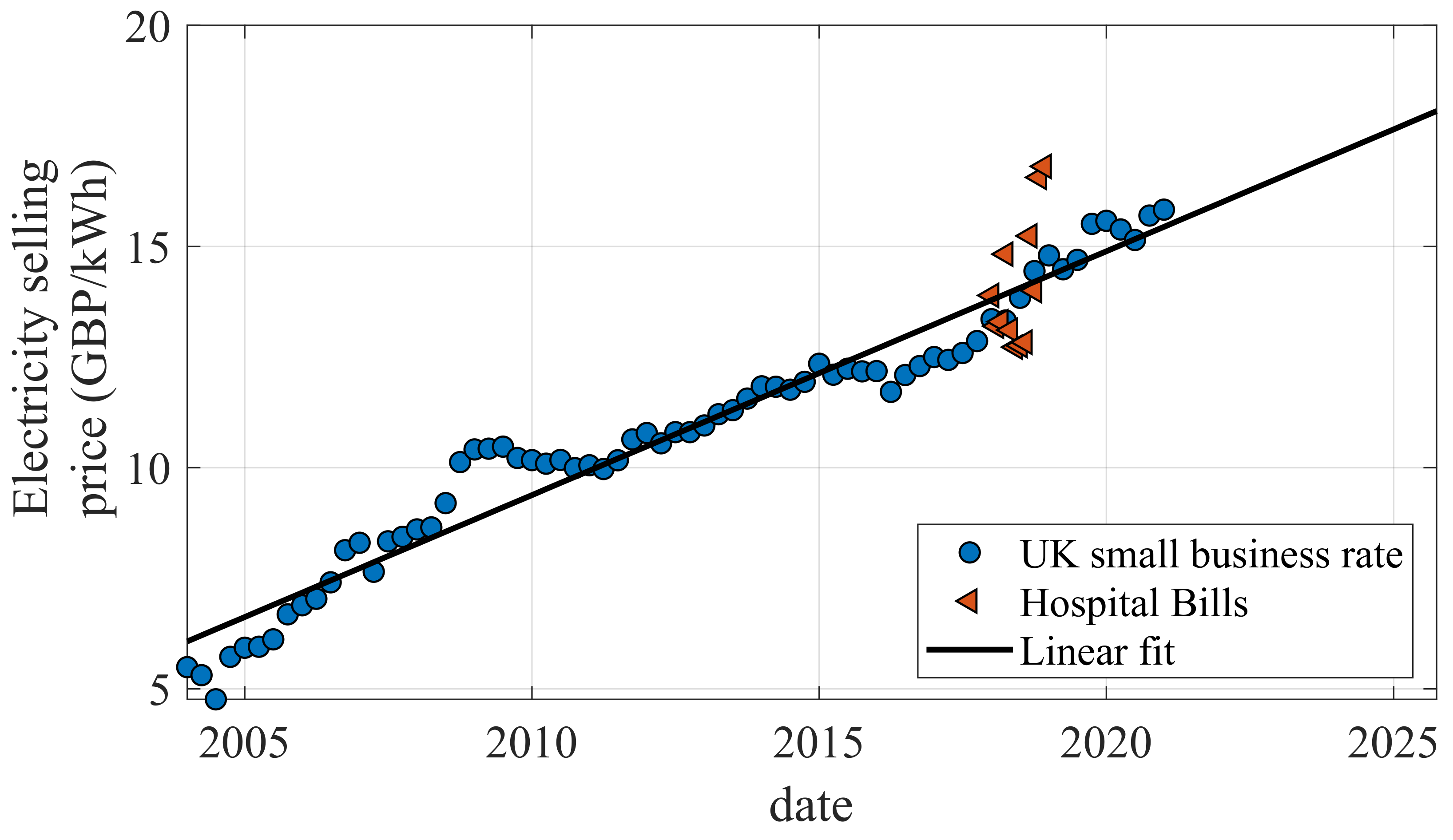
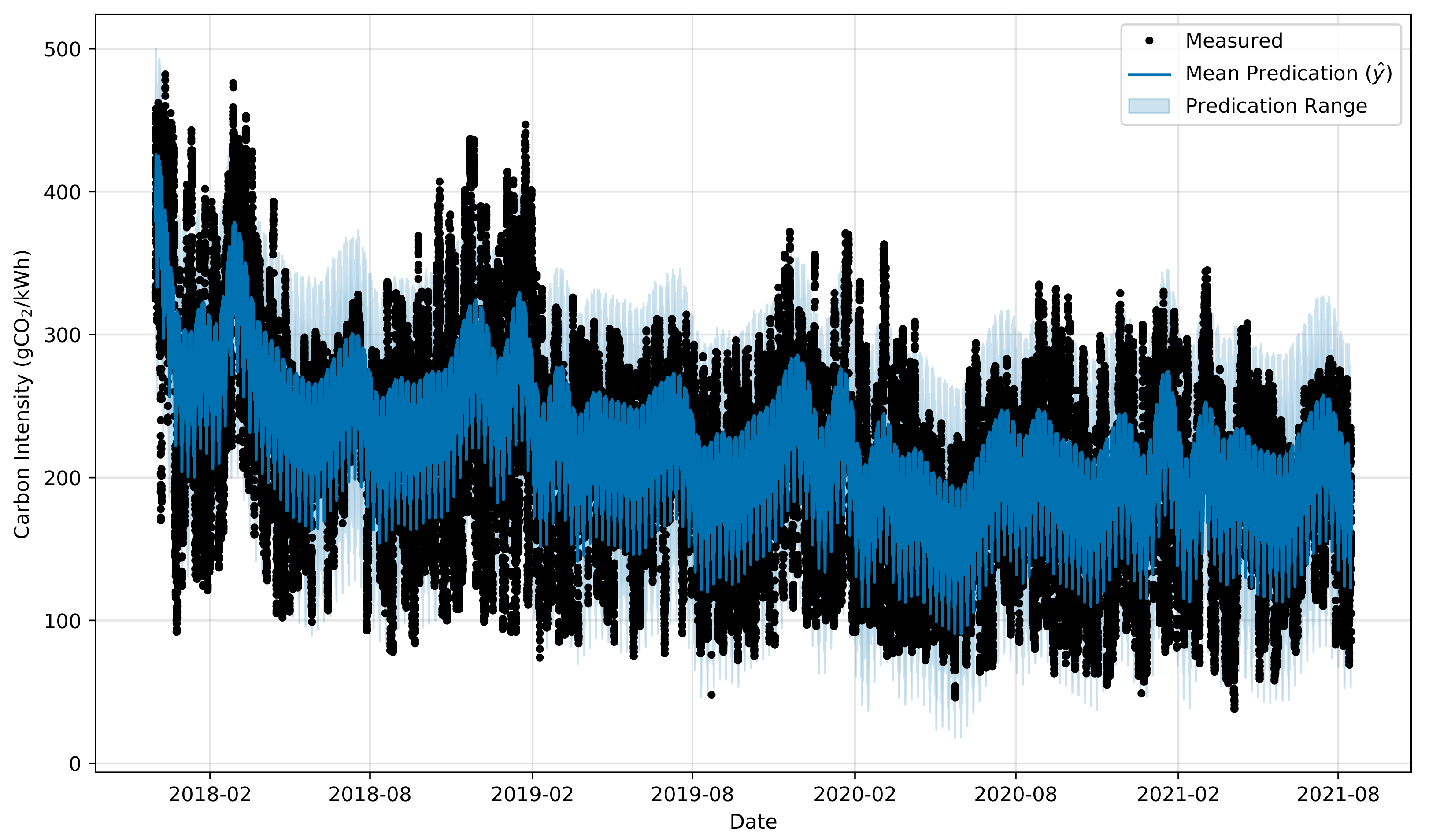
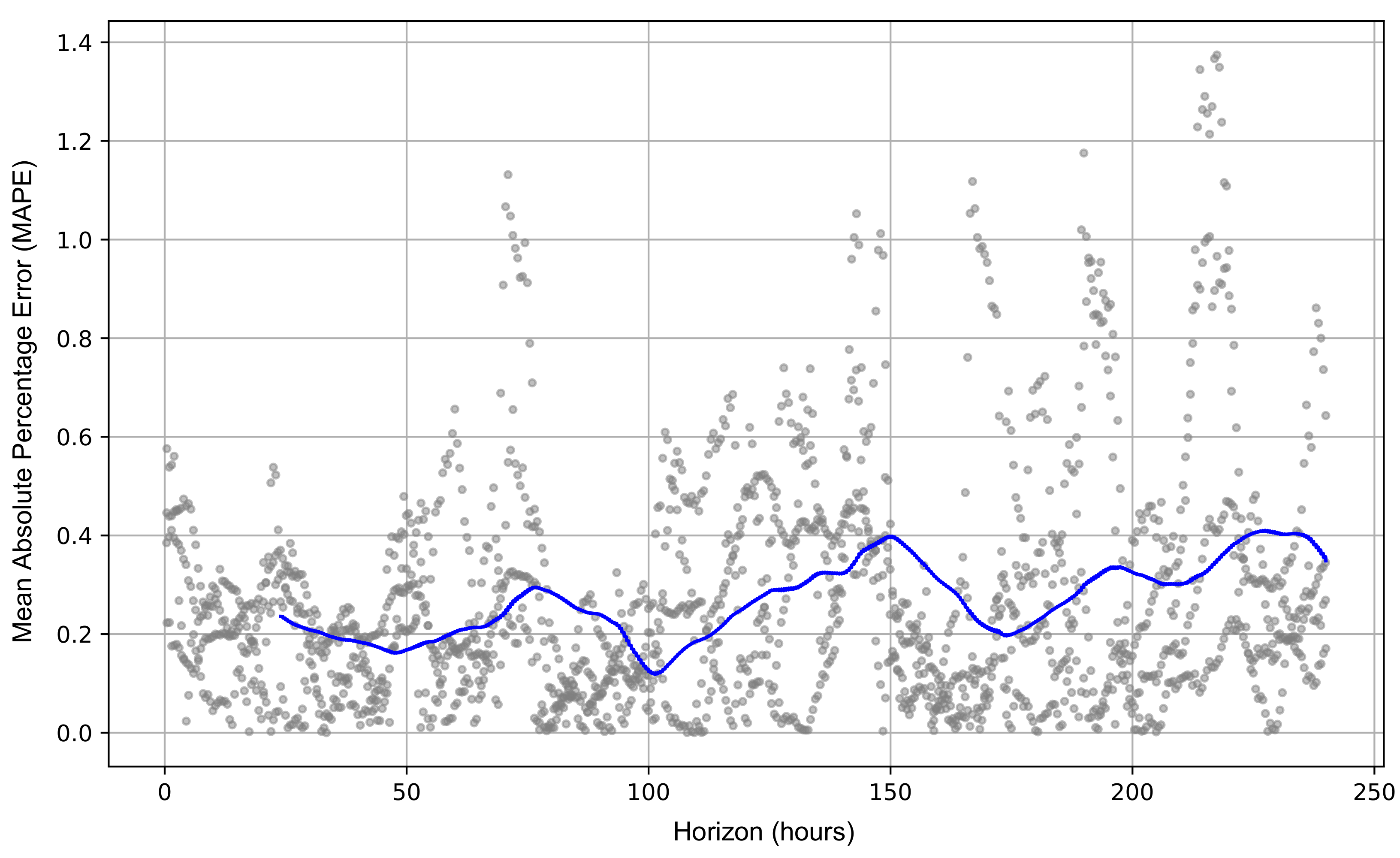
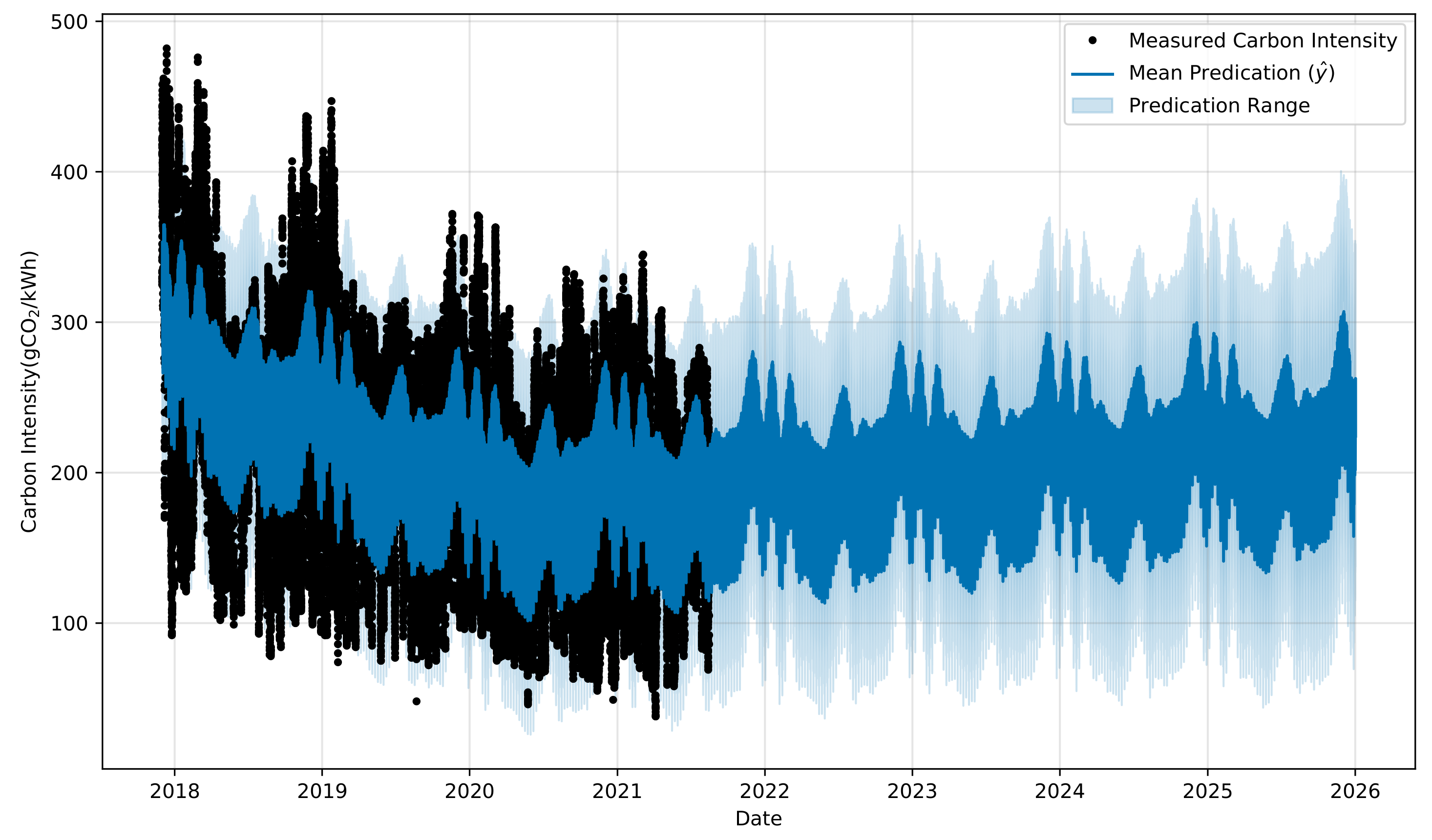
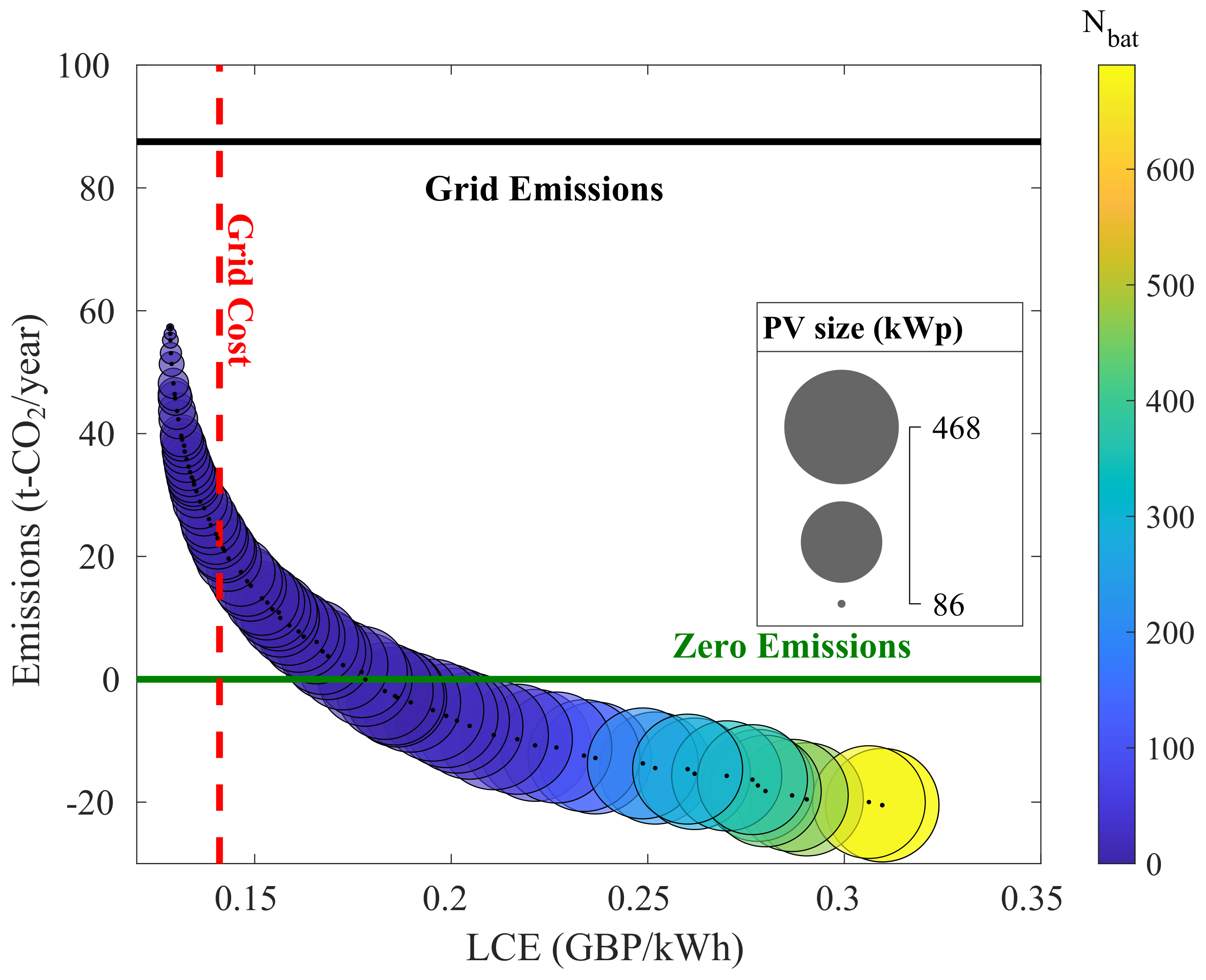
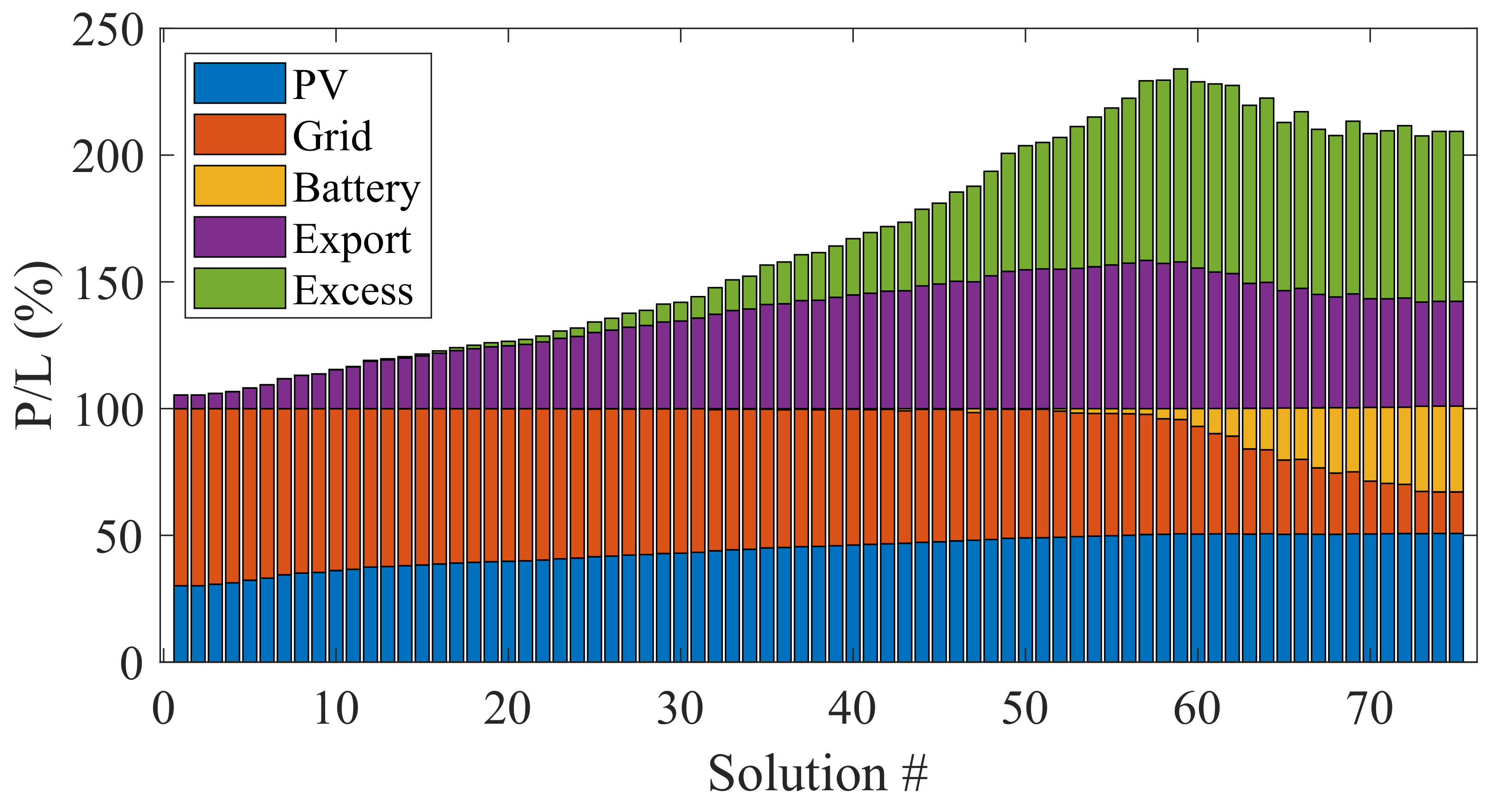
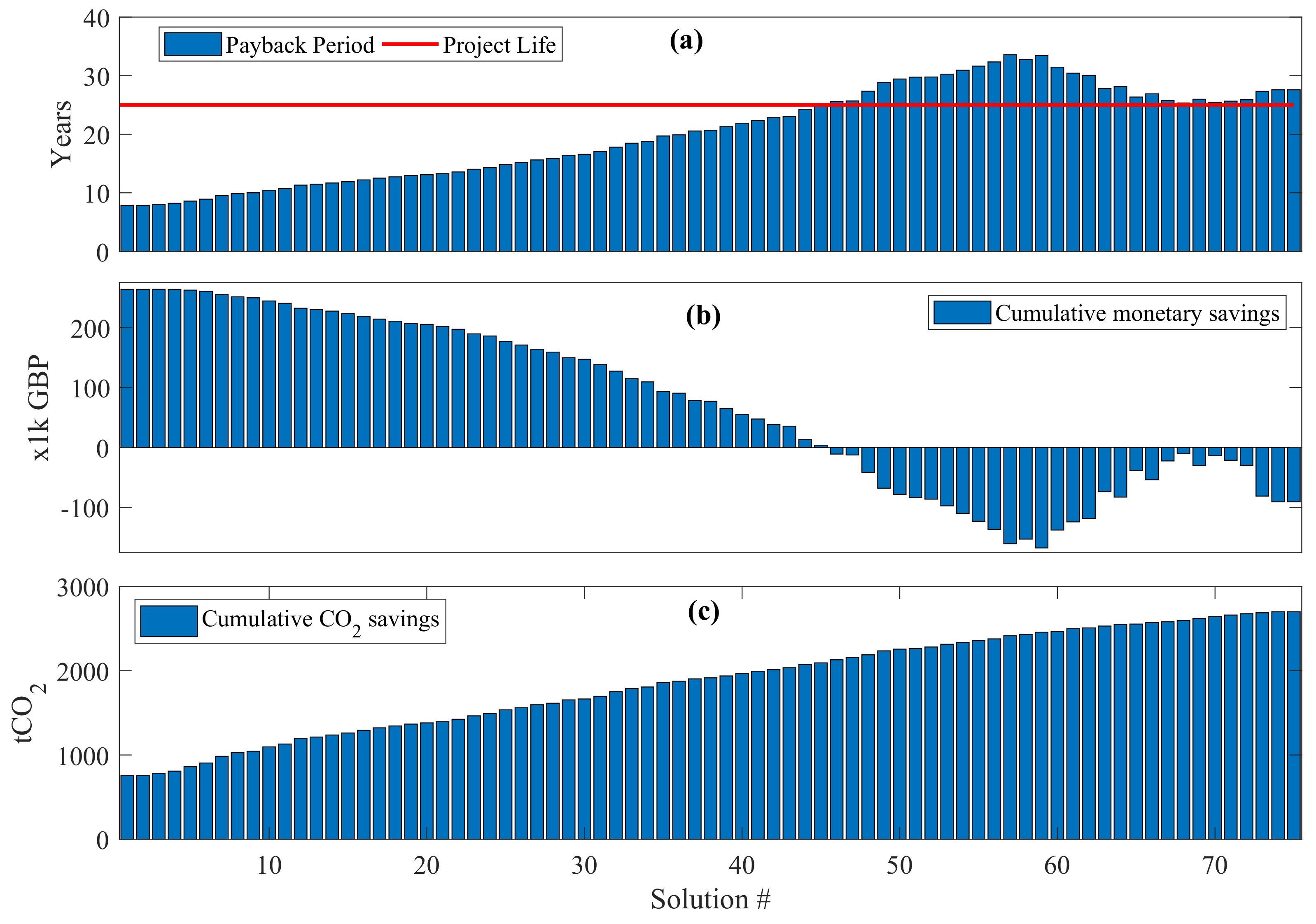
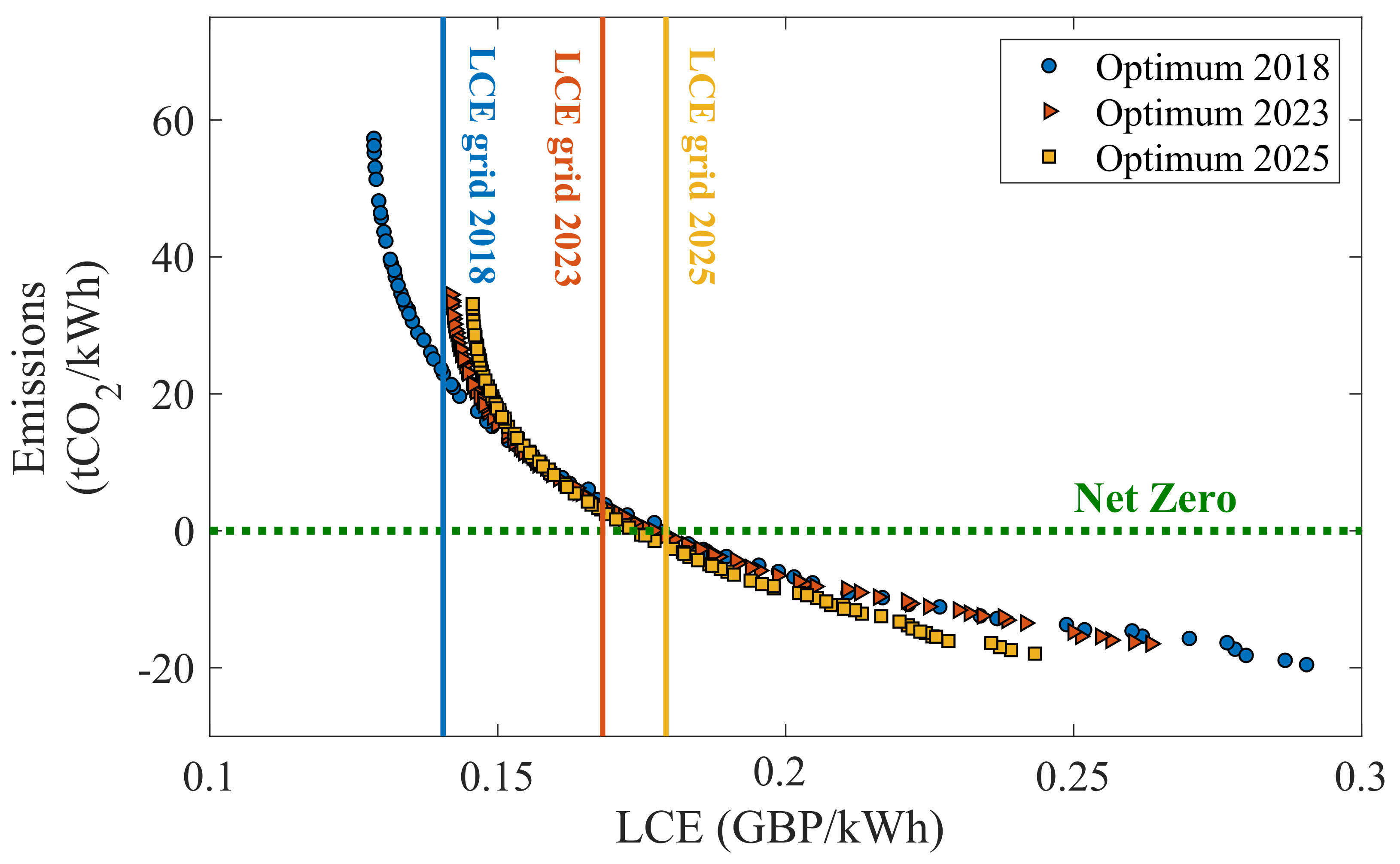
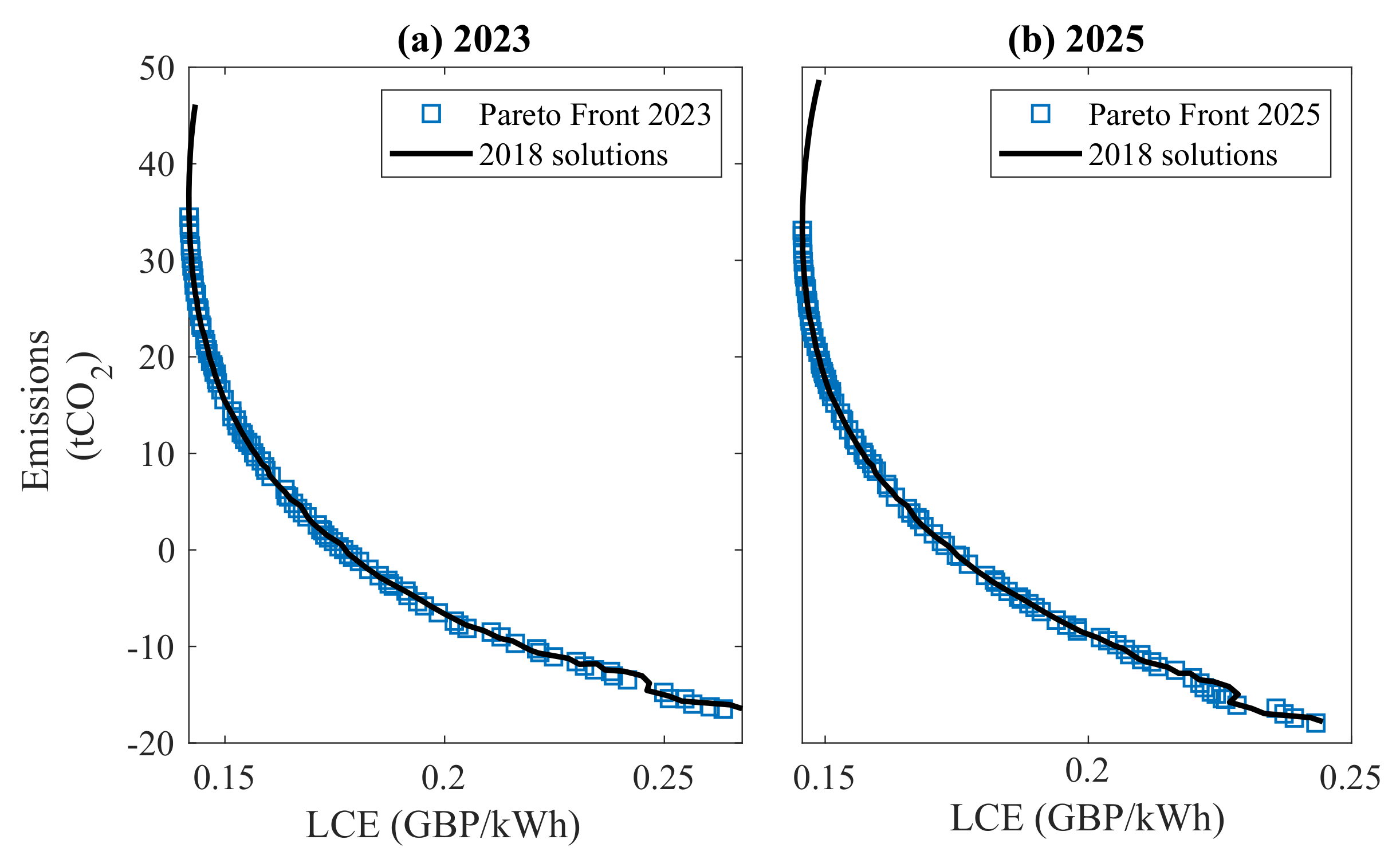
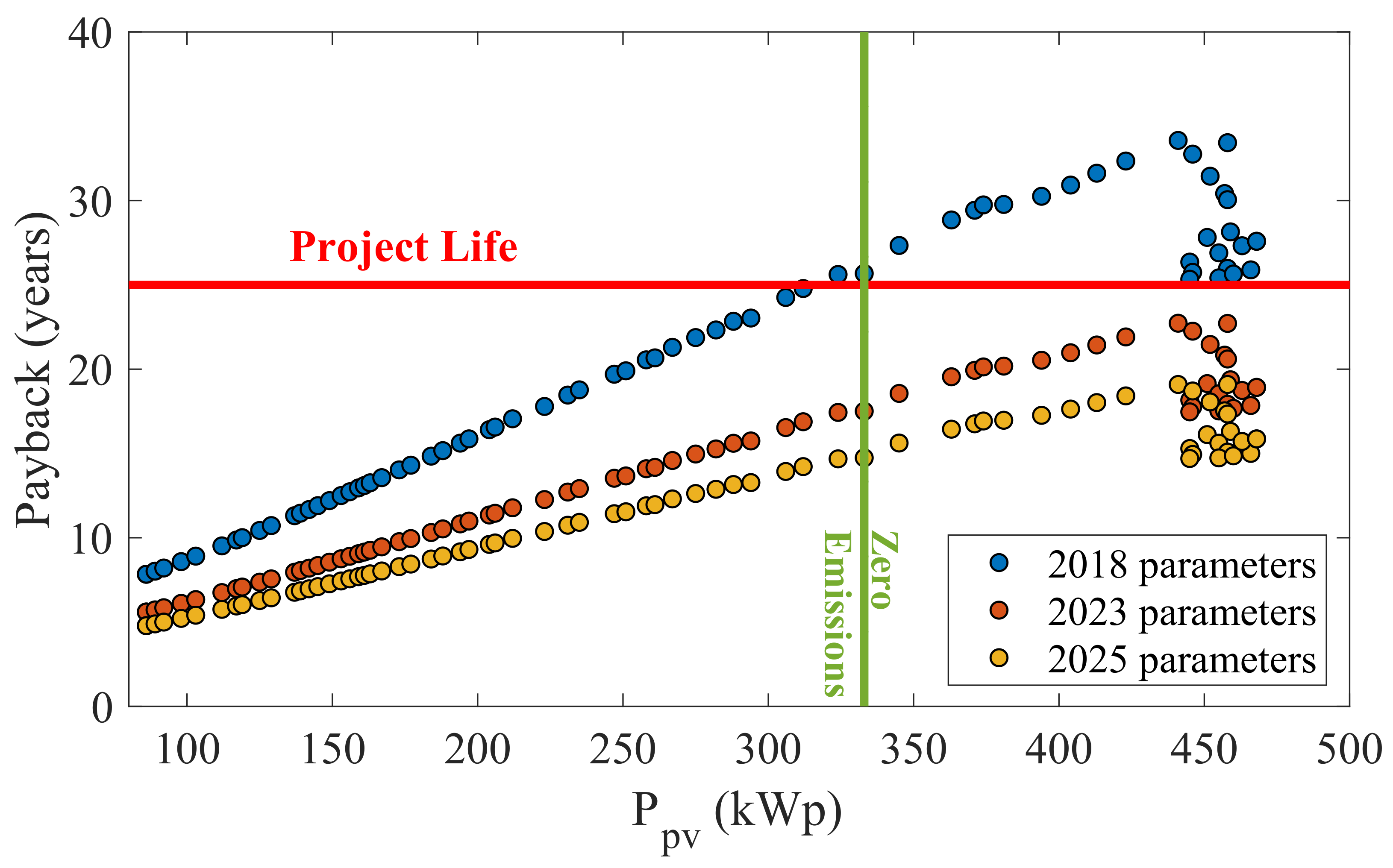
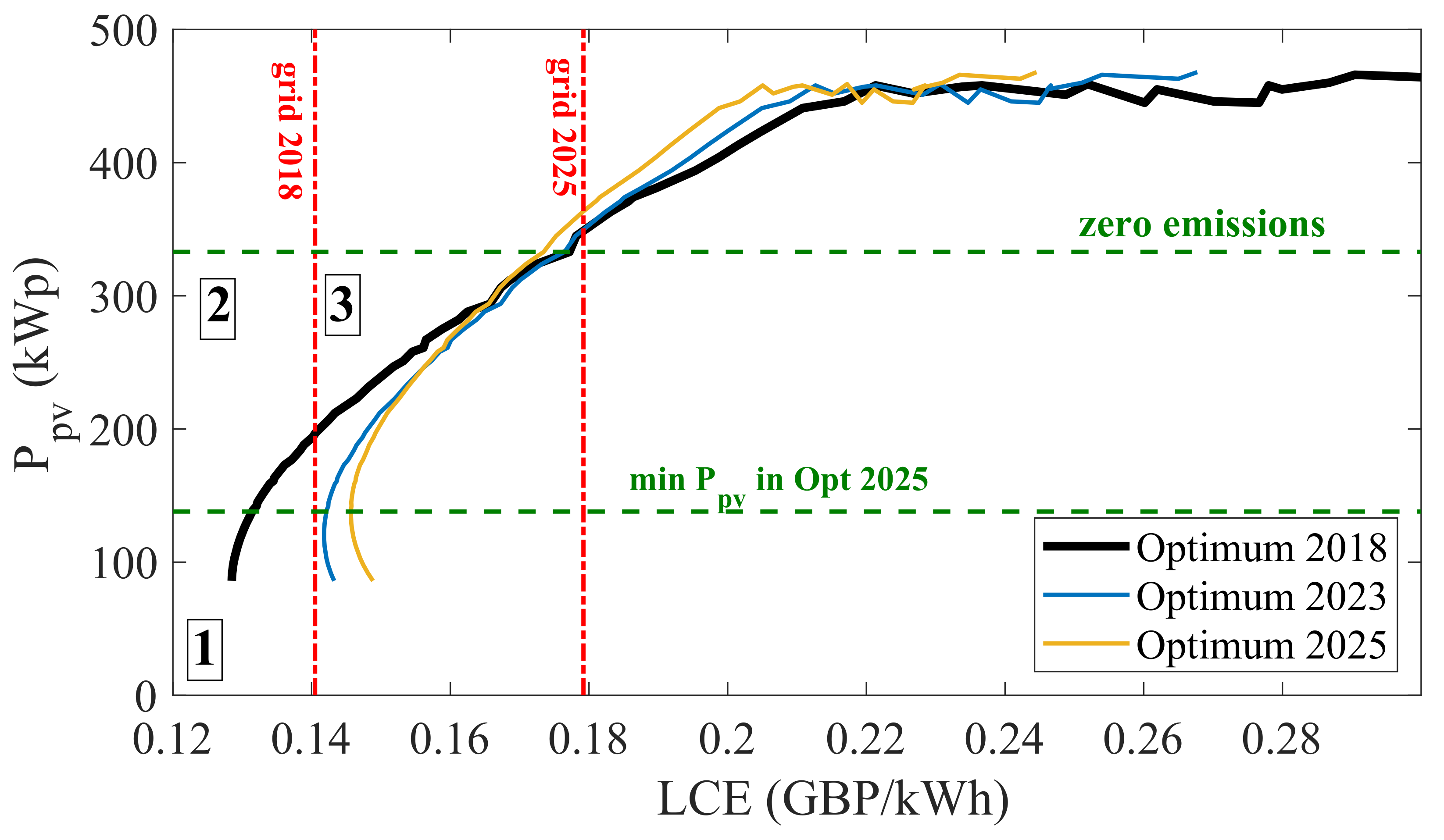
| Component | Capital | Installation | Fixed | Variable | Replacement | Exports/Salvage | Component Life |
|---|---|---|---|---|---|---|---|
| Cost (CC) | Cost (IC) | O&M | O&M | Cost | |||
| PV | GBP 50/m | 2.5 × CC | GBP 2/m | 0 | (CC + IC) | 0 | 25 min |
| Battery | GBP 300/kWh | 0.5 × CC | 0.01 × CC | 0 | (CC + IC) | Linear | (15 years, 3000 cycles) |
| Grid | 0 | 0 | 0 | variable | 0 | GBP 0.04/kWh | 25 |
| GA Parameters | Value |
|---|---|
| Population size | 200 |
| Max number of generations | 400 |
| Probability of crossover | 0.8 |
| Convergence criteria | |
| Max number of stalled generations | 30 |
| Pareto fraction | 50% |
| Number of genes | 2 |
| Type of genes | integers |
| Sol | LCE | Sol | LCE | ||||||
|---|---|---|---|---|---|---|---|---|---|
| # | (GBP/kWh) | (t/year) | (kWp) | (#) | # | (GBP/kWh) | (t/year) | (kWp) | (#) |
| 1 | 0.1285 | 57.3 | 86 | 0 | 38 | 0.1565 | 10.0 | 267 | 1 |
| 2 | 0.1285 | 56.3 | 89 | 0 | 39 | 0.1588 | 8.8 | 275 | 2 |
| 3 | 0.1285 | 55.2 | 92 | 0 | 40 | 0.1612 | 7.8 | 282 | 4 |
| 4 | 0.1287 | 53.1 | 98 | 0 | 41 | 0.1625 | 6.9 | 288 | 3 |
| 5 | 0.1289 | 51.3 | 103 | 0 | 42 | 0.1657 | 6.1 | 294 | 9 |
| 6 | 0.1293 | 48.2 | 112 | 0 | 43 | 0.1673 | 4.5 | 306 | 3 |
| 7 | 0.1296 | 46.4 | 117 | 0 | 44 | 0.1686 | 3.8 | 312 | 2 |
| 8 | 0.1298 | 45.7 | 119 | 0 | 45 | 0.1725 | 2.3 | 324 | 4 |
| 9 | 0.1302 | 43.7 | 125 | 0 | 46 | 0.1772 | 1.2 | 333 | 17 |
| 10 | 0.1306 | 42.3 | 129 | 0 | 47 | 0.1782 | 0.0 | 345 | 3 |
| 11 | 0.1313 | 39.7 | 137 | 0 | 48 | 0.1831 | −1.9 | 363 | 2 |
| 12 | 0.1315 | 39.0 | 139 | 0 | 49 | 0.1857 | −2.7 | 371 | 3 |
| 13 | 0.1321 | 38.0 | 142 | 1 | 50 | 0.1863 | −3.0 | 374 | 2 |
| 14 | 0.1322 | 37.1 | 145 | 0 | 51 | 0.1897 | −3.7 | 381 | 10 |
| 15 | 0.1327 | 35.8 | 149 | 0 | 52 | 0.1953 | −5.0 | 394 | 19 |
| 16 | 0.1332 | 34.6 | 153 | 0 | 53 | 0.1987 | −5.9 | 404 | 21 |
| 17 | 0.1336 | 33.7 | 156 | 0 | 54 | 0.2014 | −6.7 | 413 | 21 |
| 18 | 0.1340 | 32.9 | 159 | 0 | 55 | 0.2047 | −7.6 | 423 | 22 |
| 19 | 0.1345 | 32.3 | 161 | 1 | 56 | 0.2108 | −9.1 | 441 | 25 |
| 20 | 0.1346 | 31.7 | 163 | 0 | 57 | 0.2168 | −9.8 | 446 | 47 |
| 21 | 0.1352 | 30.6 | 167 | 0 | 58 | 0.2213 | −10.8 | 458 | 51 |
| 22 | 0.1361 | 28.9 | 173 | 0 | 59 | 0.2267 | −11.1 | 452 | 87 |
| 23 | 0.1372 | 27.9 | 177 | 2 | 60 | 0.2338 | −12.4 | 457 | 126 |
| 24 | 0.1384 | 26.1 | 184 | 2 | 61 | 0.2367 | −12.8 | 458 | 140 |
| 25 | 0.1389 | 25.1 | 188 | 1 | 62 | 0.2488 | −13.7 | 451 | 215 |
| 26 | 0.1402 | 23.7 | 194 | 2 | 63 | 0.2519 | −14.5 | 459 | 219 |
| 27 | 0.1405 | 23.0 | 197 | 1 | 64 | 0.2601 | −14.6 | 445 | 284 |
| 28 | 0.1419 | 21.4 | 204 | 1 | 65 | 0.2619 | −15.4 | 455 | 278 |
| 29 | 0.1423 | 20.9 | 206 | 1 | 66 | 0.2701 | −15.7 | 446 | 334 |
| 30 | 0.1434 | 19.7 | 212 | 0 | 67 | 0.2766 | −16.3 | 445 | 369 |
| 31 | 0.1465 | 17.5 | 223 | 4 | 68 | 0.2780 | −17.3 | 458 | 357 |
| 32 | 0.1481 | 16.0 | 231 | 2 | 69 | 0.2799 | −18.2 | 455 | 435 |
| 33 | 0.1490 | 15.2 | 235 | 2 | 70 | 0.2867 | −18.9 | 460 | 462 |
| 34 | 0.1519 | 13.2 | 247 | 2 | 71 | 0.2904 | −19.5 | 466 | 472 |
| 35 | 0.1532 | 12.5 | 251 | 5 | 72 | 0.3063 | −20.0 | 463 | 679 |
| 36 | 0.1545 | 11.4 | 258 | 2 | 73 | 0.3096 | −20.5 | 468 | 690 |
| 37 | 0.1561 | 10.9 | 261 | 5 | 74 | 0.3096 | −20.5 | 468 | 690 |
Publisher’s Note: MDPI stays neutral with regard to jurisdictional claims in published maps and institutional affiliations. |
© 2021 by the authors. Licensee MDPI, Basel, Switzerland. This article is an open access article distributed under the terms and conditions of the Creative Commons Attribution (CC BY) license (https://creativecommons.org/licenses/by/4.0/).
Share and Cite
Kahwash, F.; Barakat, B.; Taha, A.; Abbasi, Q.H.; Imran, M.A. Optimising Electrical Power Supply Sustainability Using a Grid-Connected Hybrid Renewable Energy System—An NHS Hospital Case Study. Energies 2021, 14, 7084. https://doi.org/10.3390/en14217084
Kahwash F, Barakat B, Taha A, Abbasi QH, Imran MA. Optimising Electrical Power Supply Sustainability Using a Grid-Connected Hybrid Renewable Energy System—An NHS Hospital Case Study. Energies. 2021; 14(21):7084. https://doi.org/10.3390/en14217084
Chicago/Turabian StyleKahwash, Fadi, Basel Barakat, Ahmad Taha, Qammer H. Abbasi, and Muhammad Ali Imran. 2021. "Optimising Electrical Power Supply Sustainability Using a Grid-Connected Hybrid Renewable Energy System—An NHS Hospital Case Study" Energies 14, no. 21: 7084. https://doi.org/10.3390/en14217084
APA StyleKahwash, F., Barakat, B., Taha, A., Abbasi, Q. H., & Imran, M. A. (2021). Optimising Electrical Power Supply Sustainability Using a Grid-Connected Hybrid Renewable Energy System—An NHS Hospital Case Study. Energies, 14(21), 7084. https://doi.org/10.3390/en14217084










